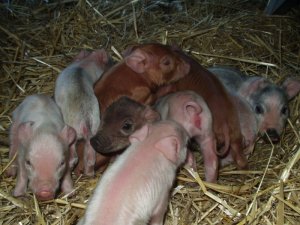By PAUL WHEATON
 At a recent event with Sepp Holzer, somebody asked Sepp for advice on what sort of liner to use for a pond. Sepp’s response was “I grade your question with an ‘F’, the lowest possible grade!”
At a recent event with Sepp Holzer, somebody asked Sepp for advice on what sort of liner to use for a pond. Sepp’s response was “I grade your question with an ‘F’, the lowest possible grade!”
Sepp has built hundreds of ponds and dozens of lakes and he never has used a liner.
When Sepp was young he had some ponds that he built that would leak. And he observed pigs wallowing, and how their wallows would go weeks without rain and hold the water.
In time, he made the connection as to why that is. And all of his pond sealing techniques attempt to emulate how a pig would go about sealing a pond.
Sepp may not have been aware that for hundreds of years, many farmers have used pigs for pond sealing.
The idea is to put them in the pond area where they will root and stomp and root and stomp and … the shape of their hooves are super packers and the soil that has been stomped on becomes densely compacted. This sealing effect is so amazing, in fact, that a lot of farmers avoid putting pigs on any land that is having drainage trouble – cuz pigs will make it worse.
When I have shared this technique on forums over the years, I inevitably get comments back from folks based on their experience with pigs and ponds, such as these:

My parents dug a pond, it leaked from the start, we tried several things when I still lived at home, but none worked. After I left home, they ran pigs in it, just fenced it in with electric fence. The pigs when in there a couple of years, the pond started holding the next spring, and has held to this day. Pigs have been gone four years now.
Quite a few years ago we built a pond that did not seal. We fenced it in and ran hogs for three years at the suggestion of my Uncle. The third year one of the piglets drowned in the pond. We moved the hogs. That pond is still holding water. I know of several other ponds done the same way. A pretty common practice around here.
Often, the discussion includes the effectiveness of a method called gley (glie/glei), a popular Russian technique using animal waste as a seal – usually filling a pond bowl with cow manure or hay, sometimes several feet deep, then channeling in such a large volume of water that the organic matter must stay submerged (I would guess this would be through fall, winter and spring).
I once saw a home where the septic drain field was buried five feet deep (instead of the recommended 18 inches). The owner also had a drain field drain into a gully (illegal). I suspect that what happened is a glie layer formed and the septic system backed up. So the owner added the illegal drain. The (legal) depth of 18 inches facilitates aerobic breakdown.

…. as for the pig manure …. I think pigs are not going to seal a pond with the gley technique. At least, not without human help. Pigs like to put their poop “over there” in a nice, tidy fashion.
So if you want pig poop to do the gley technique for a pond, you will have to go get it and put it in the pond. And you probably will never have enough pigs to pull this off. Cow poop would be a really good gley choice – but I wouldn’t want to put a cow through that: having to stand in that much poop.
So, try the rooting and stomping. Pigs love to wallow, just remember to pen them in with a single wire electric fence! So, in the end, you will get a sealed pond and some bacon!
While you are at it, listen to Sepp speak about his early aquaculture exploits, including selling crocodiles as a young boy?!
*******************
 Paul Wheaton is is the tyrannical ruler of two on-line communities. One is about permaculture and one is about software engineering. There is even one for Missoula. Paul has written several permaculture articles starting with one on lawn care that he presented at the MUD Project 17 years ago, including articles on raising chickens, cast iron and diatomaceous earth. Paul also regularly uploads permaculture videos and permaculture podcasts. In his spare time, Paul has plans for world domination from his hollowed out volcano in the Missoula area, with good submarine access.
Paul Wheaton is is the tyrannical ruler of two on-line communities. One is about permaculture and one is about software engineering. There is even one for Missoula. Paul has written several permaculture articles starting with one on lawn care that he presented at the MUD Project 17 years ago, including articles on raising chickens, cast iron and diatomaceous earth. Paul also regularly uploads permaculture videos and permaculture podcasts. In his spare time, Paul has plans for world domination from his hollowed out volcano in the Missoula area, with good submarine access.
See all of Paul’s contributions to Make it Missoula here.
